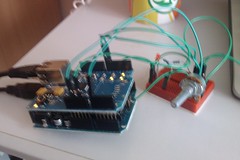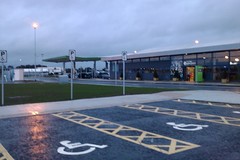The mobile phone I use is a
HTC Hero, which I bought with a
Meteor contract. In general I am very happy with both the phone itself * and the phone service which I get from Meteor which is quite reasonably priced. The one main complaint I have is that Meteor are very slow to roll out system updates. When Android 2.1 was released it was almost a year later before Meteor made the update available to their customers.
 |
| Image of the FroydVillain default home screen |
The 2.2 release of Android has been available for some time now and most commentators speak very highly of the release. Until a few weeks ago I was patiently waiting for Meteor to roll out the update to its users. However, when I got a chance to take part in the Beta program for the
Lotus Traveler product and found I needed to update to Android 2.2 to take part in the Beta, my patience finally wore out and I decided that I needed to do a manual update.
The instructions I followed were documented
here and
here. I was quite nervous about this update because it is theoretically possible to render your phone useless if this process is not done properly. Although I did not have any such serious problems I did have a few issues while doing the update. I will list here the various steps I carried out and how each one went.
- The first step in the instructions is to back up all of your personal data. Although I did this to be safe, it was not really necessary since I store all of my contact information etc. in the cloud.
- The next step was to root my phone and install the new recovery image. The rooting of the phone went very smoothly using an application named "Universal Androot". Initially I had terrible trouble installing the recovery image and I nearly gave up on the whole processes, until I discovered that the problem was caused by the fact that I had downloaded a corrupted copy of the recovery image. I needed to download a fresh copy of the recovery image from here and then it worked smoothly.
- The next step was to boot into recovery mode, wipe all of my personal data and install the new boot image. Although, there were many dire warnings that this was the most dangerous step, I found that it went very smoothly for me. However, I discovered that the link I used to download the new image no longer works, so I shared a copy on my Dropbox account here in case anyone wants to follow in my footsteps.
The moment of truth came when I turned on my phone for the first time with the new updated software. I must admit that the new UI is definitely much slicker and pleasant to use. A few of the UI elements have moved around, but it did not take me long to learn how to use the new menu structure.
The only serious issue I had was in trying to connect my phone to the company WiFi. My first attempts didn't work and I ended up with the WiFi completely broken on the phone. However, since I hadn't done much customization to the phone yet, I reset the phone and went back to the start of phone setup again and the next time the WiFi worked properly and I had no problems connecting to the company network.
Another thing that frustrated me slightly was that I was initially unable to install Lotus Traveler on my phone. When I went to the download link, entered my username/password and clicked OK I got the very helpful error message "-1". Luckily my colleague
Fred Ragilaut was able to tell me that the problem was that the screen lock password was not complex enough to meet the IBM security standards. I suppose it is reasonable to impose such restrictions, but it would have been nice if the error message gave me some clue why it was refusing to install. Once installed the Lotus Traveler is a joy to use, but I will write another blog post about that later.
* The HTC Hero was the best phone available at the time I bought it, but there are much better phones available now.


 If you are like me you have probably carelessly subscribed to several mailing lists and you find the regular emails from these merchants to be vaguely annoying. Most of these maliing lists would probably remove you from their mailing list if you took the trouble to follow their process for unsubscribing. However, this can be a lot of trouble and there is always the risk that the senders are unethical hackers and will treat your click on their unsubscribe link as encouragement to send you more annoying emails.
If you are like me you have probably carelessly subscribed to several mailing lists and you find the regular emails from these merchants to be vaguely annoying. Most of these maliing lists would probably remove you from their mailing list if you took the trouble to follow their process for unsubscribing. However, this can be a lot of trouble and there is always the risk that the senders are unethical hackers and will treat your click on their unsubscribe link as encouragement to send you more annoying emails.
 Some people are very effective at using a methodology like
Some people are very effective at using a methodology like  I just discovered a brilliant site
I just discovered a brilliant site 



 Earlier this week, I wen to see
Earlier this week, I wen to see 


 I just learned that my first ever patent was issued. The title of the patent is "METHOD AND SYSTEM FOR LANGUAGE IDENTIFICATION" and the full text can be download
I just learned that my first ever patent was issued. The title of the patent is "METHOD AND SYSTEM FOR LANGUAGE IDENTIFICATION" and the full text can be download 







 The Open Source Software (OSS) Barcamps are "un-conference" type events that are held every 6 months or so to promote all things relating to open source software. I have attended a few of these and always found them to be very interesting. IBM hosted the last event in April of this year, but I was not able to attend due to injury. The next event is scheduled to take place in University College Dublin this coming weekend.
The Open Source Software (OSS) Barcamps are "un-conference" type events that are held every 6 months or so to promote all things relating to open source software. I have attended a few of these and always found them to be very interesting. IBM hosted the last event in April of this year, but I was not able to attend due to injury. The next event is scheduled to take place in University College Dublin this coming weekend.
 The
The 

 The
The